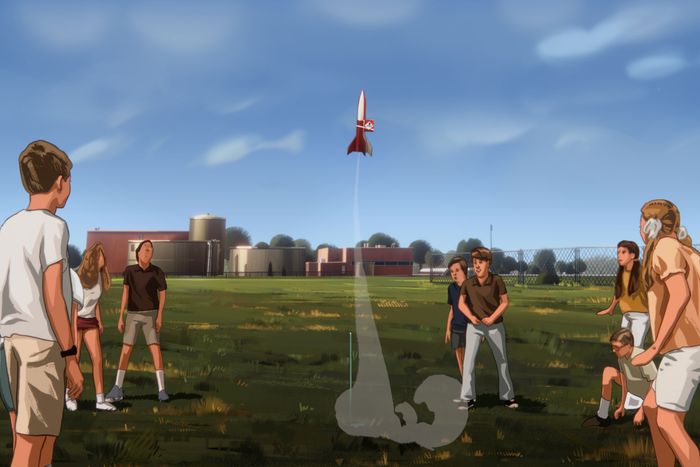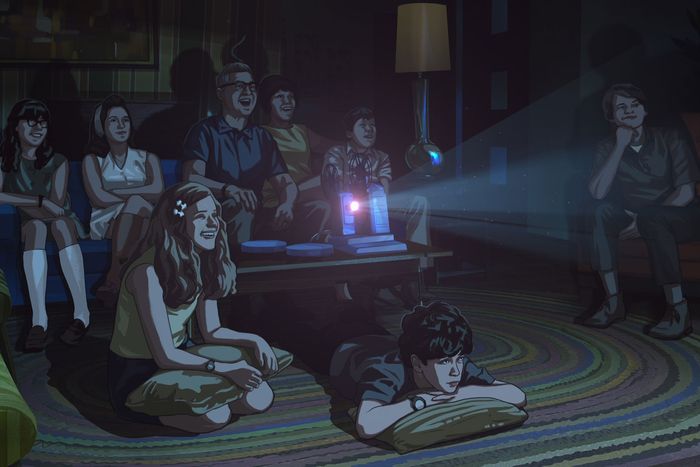
Update, November 10: The Academy has revised its decision on the eligibility of Apollo 10 ½ and several other animated films.
Original story follows:
Richard Linklater’s Apollo 10 ½: A Space Age Childhood looks like no other animated film this year — not like the smooth CGI of Pixar’s Turning Red, or the stop-motion of Guillermo del Toro’s Pinocchio, or the angular line work of the action anime Inu-Oh. Apollo 10 ½ was made, like Linklater’s previous films Waking Life and A Scanner Darkly, by filming live actors and then painstakingly tracing over their movements, a process called rotoscoping. Linklater and his animation director, Tommy Pallotta, hired nearly 200 animators to bring the film to life, but it seems their efforts weren’t transformative enough for the Academy Awards to acknowledge them. In July, the Oscars’ animation committee rejected the film’s bid for eligibility in the Best Animated Film category. Due to “extensive use” of live-action footage, the committee wrote, the Academy “does not feel that the techniques meet the definition of animation in the category rules.”
Linklater and Pallotta are pissed. “It’s so disrespectful to the animators and the hundreds of thousands of hours spent. I would invite anyone who thinks this is an automated process: You deliver a 30-second short with this level of detail and come back and tell us it’s not animated,” Linklater told Vulture. Earlier this month, Pallotta told IndieWire, which first broke the news of the Academy’s ruling, “I feel like I’ve been caught in a Kafkaesque nightmare where someone is saying something isn’t real and I know it’s real.” The two are in the process of appealing the decision. (The Academy, so far, has not commented on the appeal.) But the pair’s exasperation makes a lot of sense the more you know about the film and about the specific process of rotoscoping.
For one, Apollo 10 ½ doesn’t have any shots in it that a reasonable viewer could call live-action. It adheres to the Academy’s eligibility rules about this, which stipulate that more than 75 percent of the film’s running time and its major characters must be animated. Linklater says he and the film’s team sent in several clips of production material, including a compilation of examples that isolate nearly every layer of labor that went into each shot: a painted background, illustrated background characters, live-action footage of central characters, those characters’ rotoscoped outlines, painted shading and highlights, character placement on the backgrounds, and finally, the composite as it appears in the finished film. The compilation Vulture reviewed breaks down nearly two dozen shots, crafted by a staff Pallotta described to us in April as mostly “older 2-D artists and animators.” He pointed out that Apollo 10 ½ is actually more grounded in traditional animation techniques than 2006’s A Scanner Darkly, his and Linklater’s last animated film. “Scanner used interpolation for the rotoscope. So you would draw a line, and the computer filled it in. We didn’t do any of that on this. We really looked at the older 2-D-animation methods and relied on the creativity and the brute force of people’s hands doing the work.”
Second, the “older 2-D animation methods” Pallotta describes date back to the earliest days of cartooning. A lot of early animation is actually indistinguishable from what we’d today call special effects superimposed onto live-action filmmaking. The rotoscope itself — a machine that allows animators to trace a projected silhouette of a live-action film — was invented by visionary animator Max Fleischer in 1915 and became a cornerstone in the history of the medium. To thumb your nose at rotoscoping and its place in the art form is to disregard Cab Calloway’s dancing in Fleischer’s Minnie the Moocher, the mind-tripping weirdness of Ralph Bakshi’s The Lord of the Rings, and even Walt Disney’s Snow White and the Seven Dwarfs — among literally thousands of other cartoons over the decades. Without rotoscoping, the lightsaber would never have glowed in Star Wars, and Disney, the powerhouse that dominates the Oscars’ animation category year after year, might not own Lucasfilm and its roster of animated films and TV shows today. Minnow Mountain, the Austin-based animation studio behind Apollo 10 ½, laid out the contradiction in stark terms: “This independent film, using a 100-year-old hand-drawn 2-D animation technique, has been rejected from an animation category dominated by big-budget films made with cutting edge 3-D technology.”
Third, Linklater calls Best Animated Feature a category “run by corporations” and aimed at children. Put delicately: The group’s voting history bears this out. Put less delicately: The homogeneity of this particular award is an atrocity — laughably unrepresentative of the inventiveness of its medium. Of the 21 awards for Best Animated Feature that have been presented since 2002, 19 went to CG-animated kids’ films; filmmakers have complained that even some of the show’s presenters have begun to infantilize the art form onstage. Linklater credits Studio Ghibli’s Spirited Away, which won nearly 20 years ago, for creaking open the only “weird slot” in the category’s history. No 2-D animated film has won since. Just two privately owned animation studios have ever brought home the trophy: Studio Ghibli for Spirited Away (2003) and Aardman Animations for Wallace & Gromit: The Curse of the Were-Rabbit (2006). Disney alone, if you include Pixar’s wins, claims ownership of 15 of those awards.
This is bad. Not just for Pallotta and Linklater and their movie, but for anyone who hopes that this art form survives beyond the dominance of CGI. Year after year, it feels vanishingly likely that we’ll see new movies like Apollo 10 ½, a feature-length production that, though released by a mega-company of its own in Netflix, looks strikingly different from the mass-marketed CGI that dominates year after year. (Netflix, Linklater said, has “been as supportive as you would expect” of the Oscar bid.) It’s not as if hiring all those 2-D animators was comparatively expensive; they cost Linklater and his producers $20 million, a fraction of what a Pixar or Disney Animation film costs to make. “It should be an exciting time for animation, but there’s just this status quo pressure” to make films according to industry trends, Linklater said. “I just hate that it’s thwarting people’s potential to express themselves in different ways.”
What’s all the more vexing is how this situation thematically collides with Apollo 10 ½, which dramatizes its hero’s closeness to his space-age dreams through its similitude to real life. Look at the way it handles television broadcasts. They’re mostly patchy, grainy, choppy riffs on the film’s rotoscoping style. The “picture” on the characters’ TV is fuzzier, reflective of the ’60s, hammering home that Apollo 10 ½ was made to capture a specific level of realism, not reality (or live-action) itself. It helps us understand the medium as the film’s message — that the artistry conveying a child’s fantasy about helping NASA get to the moon is, in fact, the point.
Linklater and Pallotta have yet to receive an update from the Academy since they submitted their appeal on September 12, a process the director characterizes as cryptic, slow, and like an adversarial court proceeding. “For all we know, it’s six people. We don’t know if we’ve gotten their attention yet,” he said. “They’re making an aesthetic choice that really should not be theirs to make. That’s what feels patently unfair. There really shouldn’t be aesthetic rules.” Maybe the only consolation, if it is one at all, for Linklater, Pallotta, and fellow rotoscoping animators is that their frustrations place them in esteemed company. Ralph Bakshi used the technique for his Lord of the Rings, Wizards, Fire and Ice, and other films pointedly not made for kids, and he never won an Academy Award either. “It’s so bleepin’ difficult coming up against the Disney monolith,” he told the New York Times in 1981. “Everyone’s trying to keep animation as cartooning in style and talking animals and fairy-tale folk in subject matter. Why must it be that way? I’m not big on Father Figures, and I despise rules in art. No one wants to change. They want to do it the way Walt did — and not as good — till the day they die, and that’s the curse.”



